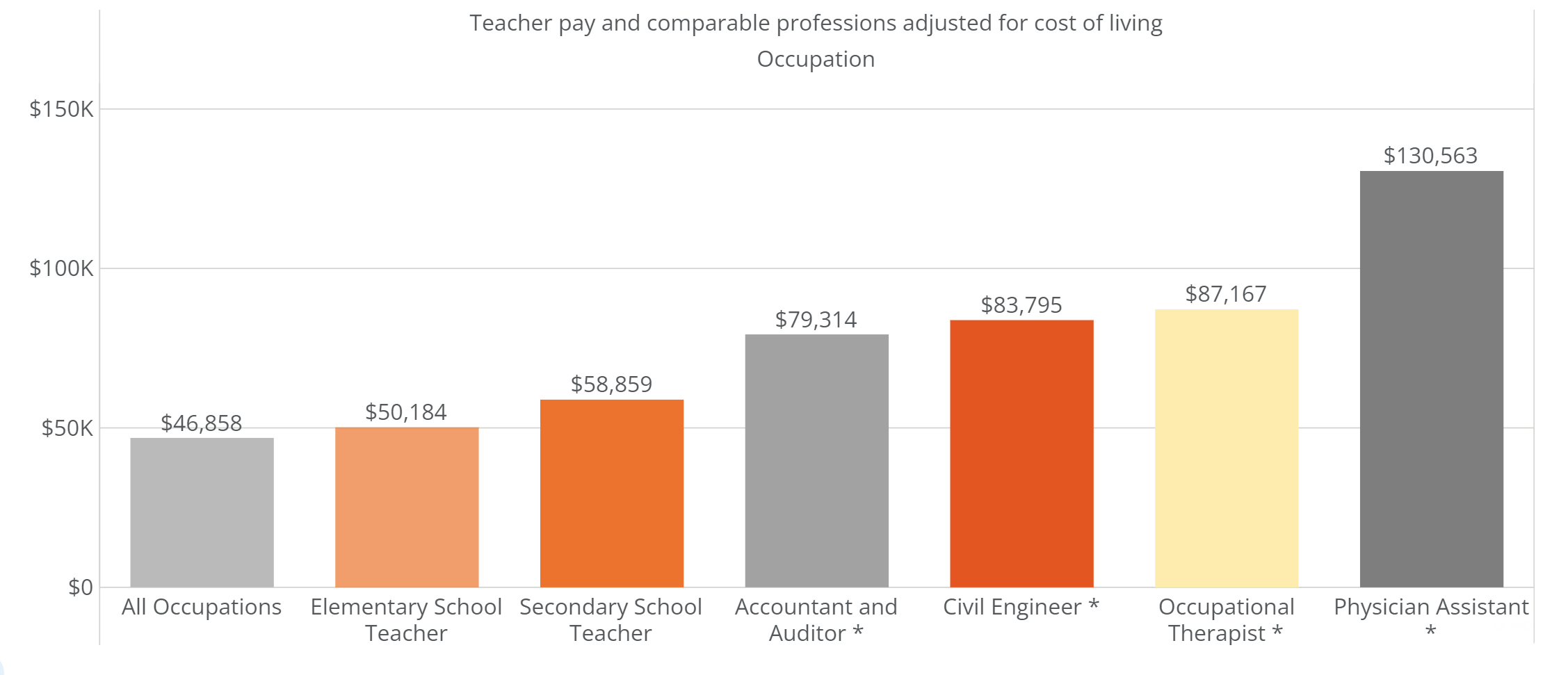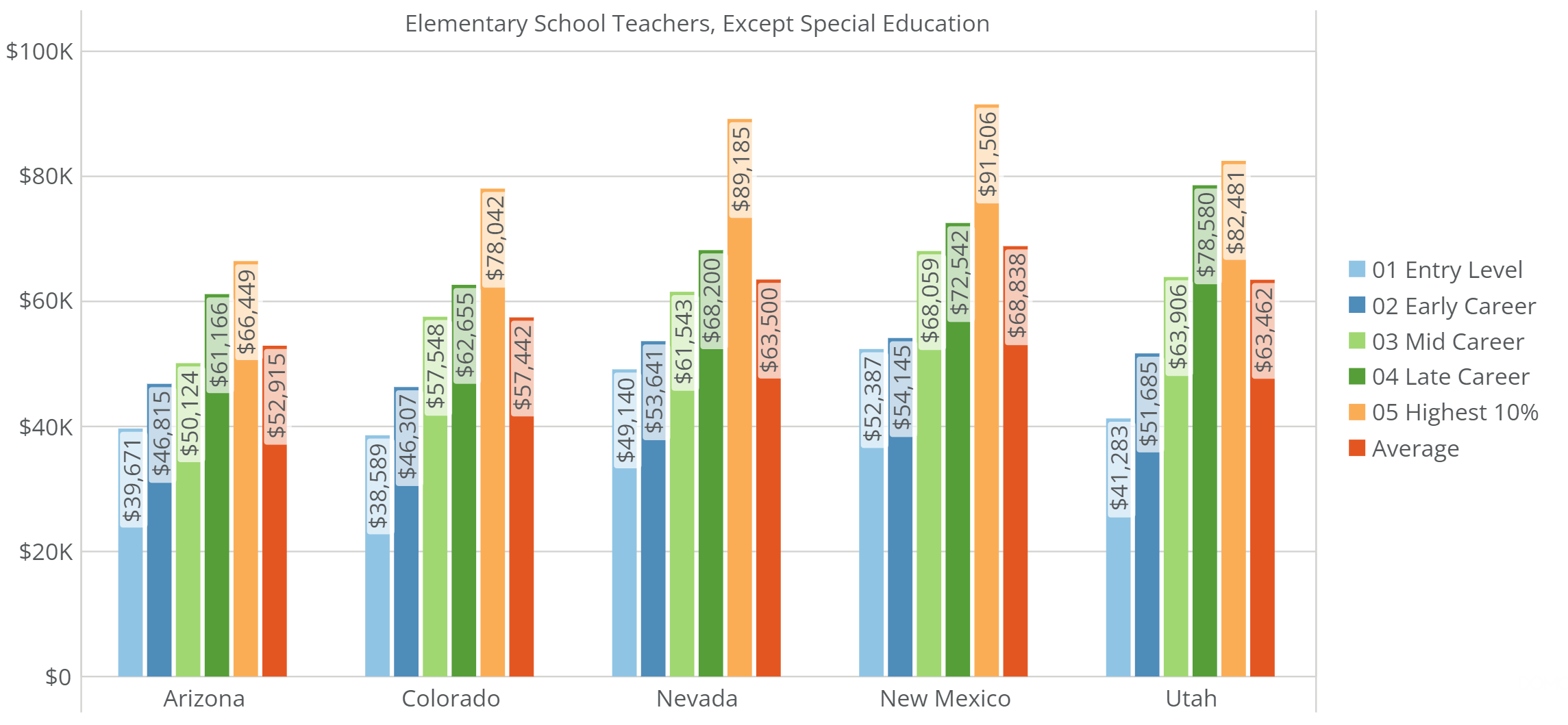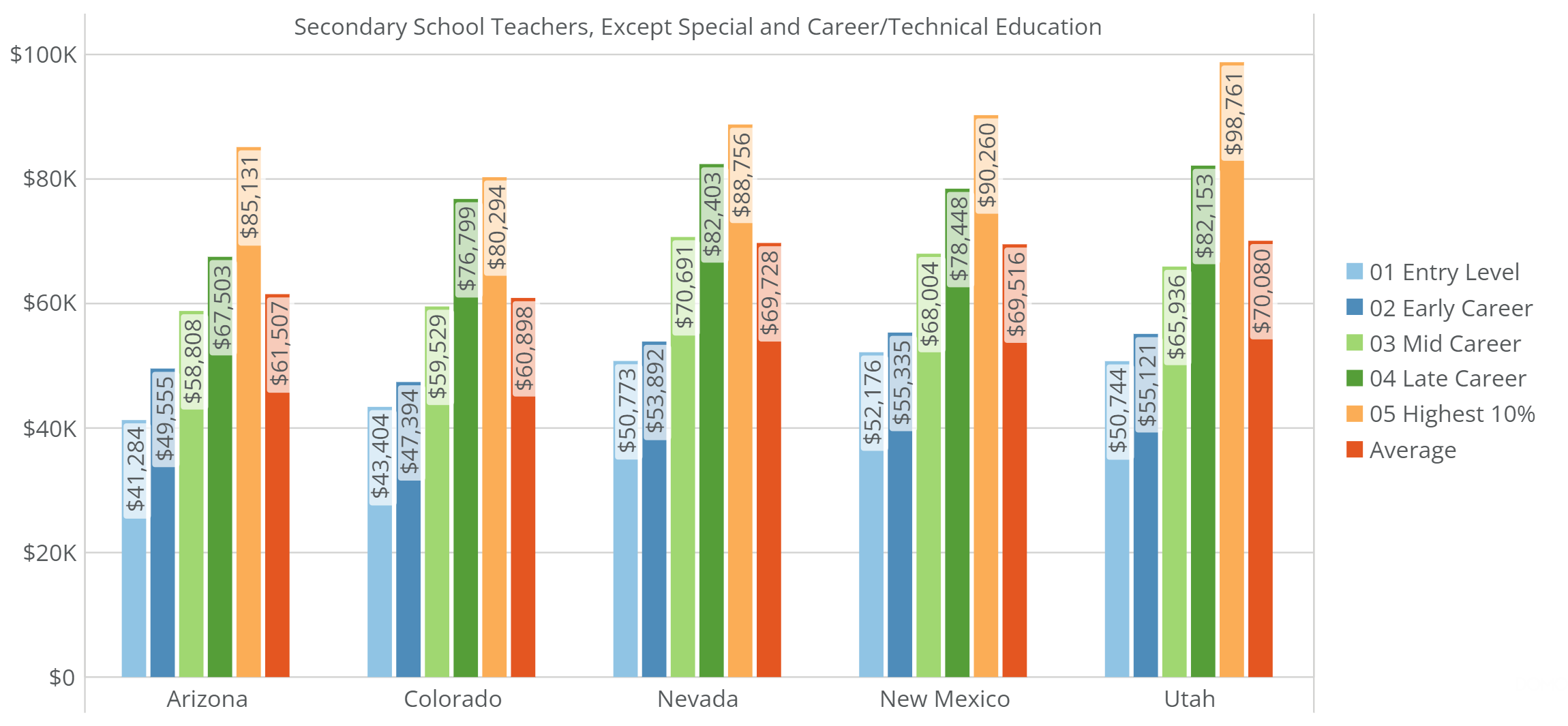Arizona Progress Meter Update Despite Progress, Arizona's Teacher Pay Lags Behind Other States

Center for the Future of Arizona (CFA) and Education Forward Arizona recently released updates to the Arizona Education Progress Meter, the state’s widely accepted framework for measuring P-20 education
To effectively and consistently measure the state’s education system, CFA and Education Forward Arizona worked with leaders and organizations across the sector to establish metrics and goals that comprise the Arizona Education Progress Meter. Of the eight metrics, seven are outcomes at various levels of the P-20 continuum. One metric, teacher pay, is designed to reflect an important aspect of educational success, the need to retain qualified and skilled teachers.
The Teacher pay metric in the Arizona Education Progress Meter is defined as the ranking of Arizona’s elementary and secondary school teachers’ adjusted median annual pay as compared with other states.
The most recent update is for the 2022 calendar year. It shows that Arizona’s elementary school teachers had an annual median adjusted income of just over $50,000, and high school teachers made almost $59,000. This is compared with a national median of just over $55,000 for elementary school teachers and about $59,000 for high school teachers.
The annual update for teacher pay includes a comparison of Arizona’s adjusted median annual pay with the other 49 U.S. states. This comparison allows the ranking to determine if Arizona is competitive in median salary. To support an understanding of the pay, the Arizona Education Progress Meter includes a comparison with other professions that require a similar amount of education and training, including civil engineers, accountants, occupational therapists, and physician assistants.
First, the median annual salary is adjusted to reflect the differences in cost of living to ensure all states are on equal footing, then the pay is ranked high to low, with the highest ranked #1 and the lowest as #50. Since the start of the metric, Arizona’s teachers have ranked near the bottom and only recently have secondary school teachers progressed from nearly last placement to a more central one within the rankings. (Figure 1)

Figure 1: Arizona's ranking as compared to the other 49 states of adjusted annual median pay has been near the bottom for both elementary and secondary school teachers since 2016.
Across Arizona in 2022, the adjusted median annual salary for all occupations was almost $47,000, below the pay of elementary school teachers at about $50,000 and secondary school teachers at almost $59,000. (Figure 2) Though lower than most other states, the pay is much higher than when data began to be collected in 2016 when elementary and high school teachers’ adjusted median annual pay was $43,000 and $46,000 respectively. Though these gains are notable, pay has increased across the nation at a similar pace, preventing a significant improvement in Arizona’s comparative ranking. It is worth noting that the 2022 salary data for elementary school teachers is about 17% higher, and secondary school teachers have an adjusted pay that is about 27% higher than 2016, reflecting the policy priorities of state leaders to substantially increase salaries.

Figure 2: For 2022, Arizona's elementary school teachers' annual adjusted median pay of about $50,000 was just over the median for all occupations. High school teachers had incomes closer to $60,000.
Taking a more in-depth analysis of the data from the Bureau of Labor Statistics, which informs the teacher pay metric, provides some insights into overall teacher retention for Arizona as compared to other neighboring states. In figures 3 and 4, a comparison is drawn between the adjusted salaries of elementary and secondary school teachers at various stages of their career with some of Arizona’s neighboring states.
The following observations are instructive at understanding the pay situation for elementary school teachers:
- Arizona’s entry level pay is comparable with two of the four neighboring states at about $40,000
- The 25th percentile pay, early career, is also competitive with Utah and Colorado, though Nevada and New Mexico remain higher
- Pay for late career and the highest 10% of earners lags significantly behind neighboring states which may indicate a lower wage overall for teachers, or more likely, it reflects a lower overall share of teachers who have reached this stage of their career

Figure 3: Arizona's entry-level pay is comparable with some of its neighboring states. Note the significantly lower salaries for middle, late career and highest 10%, likely reflecting a lack of senior-level teachers as compared with its neighbors.

Figure 4: Arizona's entry level pay is lower than its neighbors, but senior-level teachers in secondary school can have very competitive salaries.
Secondary school teachers have a more competitive overall situation than their peers in primary school including:
- A lower entry wage than neighboring states at $41,000
- Competitive early career wages of about $50,000
- Lower overall late career wages than all neighboring states in upper $60,000 as compared with upper $70,000 and $80,000
- The top wage earners can be very competitive with other states with the upper 10% of secondary school teachers making at least $85,000
Overall, the teacher pay update indicates areas for continued attention as well as some positive trends including:
- Arizona’s adjusted median pay for elementary school teachers is last in the nation, and for high school teachers, its rank stands at 38th among the 50 states
- A significantly higher adjusted median wage than in previous years for both elementary and high school teachers
- Competitive entry-level wages for elementary school teachers with some neighboring states
- Lower late-career wages, or a general lack of senior-level elementary school teachers as compared with Arizona’s neighbors
- High school teachers entering the workforce have a lower overall entry wage but have the potential for competitive late career salaries
Arizona’s residents support competitive pay for teachers to ensure that our education system is high quality. While there have been certain advancements, the attraction and retention of high-quality educators is important for Arizona to reach the goal of providing every student access to an education that prepares them for post-secondary education and the workforce.
Why is Teacher Pay Important?
CFA’s recent Gallup Arizona Survey that identified Arizonans’ seven Shared Public Values, including Education, explored a series of actions that should be prioritized by 2030 to improve the lives and futures of residents.
- 92% of residents 18-years-old and older believe it’s important that every public school has enough highly qualified teachers and principals.
- In addition, only 26% of respondents believe Arizona’s public K-12 education is high quality.
In 2022, CFA surveyed likely voters and discovered significant support for increasing the pay of school teachers including support by 88% of all likely voters, 80% of Republicans, 98% of Democrats, and 90% of Independent/unaffiliated voters. With competitive salaries, and other retention efforts for quality teachers in elementary and high school, Arizona’s children will benefit from having qualified and effective instruction in every classroom.
Dig Deeper – Analyze Data to Support Investment and Action
Data are available to compare Arizona’s salaries with other states. Learn more and find all data and tools, including a new interactive comparison of adjusted median annual pay, at the Arizona Education Progress Meter.
Reach out to our team if you have questions or need assistance with the data tools.
About Our Data Sources
As with all Arizona Progress Meters, data are publicly available from a trusted and regularly updated source. The Bureau of Labor Statistics through the Occupational Employment Statistics (OES) program provides data used in the education metrics. To adjust the median pay for cost of living, the Regional Price Parities from the Bureau of Economic Analysis are used by the Morrison Institute to support the fair comparison of salaries.
Importantly, the data used for this metric has limitations but is believed to be the best available at comparing Arizona’s pay with other states. The data released in April 2023 for this metric are an aggregate of six panels of survey data collected over 3 years, resulting in a sample size of ~1.1 million establishments. This covers approximately 80 million out of the 139 million employed. Detailed Methods and Reliability information for the OEWS Survey can be found here. Because the data are collected over a 3-year period, it is not suitable for year-over-year salary comparison, and it is slow to reflect immediate changes.
For more information, see our full methodology.
About Arizona Progress Meters
CFA developed the Arizona Progress Meters as a tool for policymakers, business leaders, civic leaders, educators, and others across the state to understand how Arizona is doing in areas critical to achievingThe Arizona We Want.Eight Arizona Progress Meters provide valuable and regularly updated data on 80+ metrics in education, jobs, healthcare, environment, civic engagement, infrastructure, and more to support policymakers and other leaders’ data-driven dialogue, decision-making, and action.Learn more and leverage all the Arizona Progress Meters today >>
